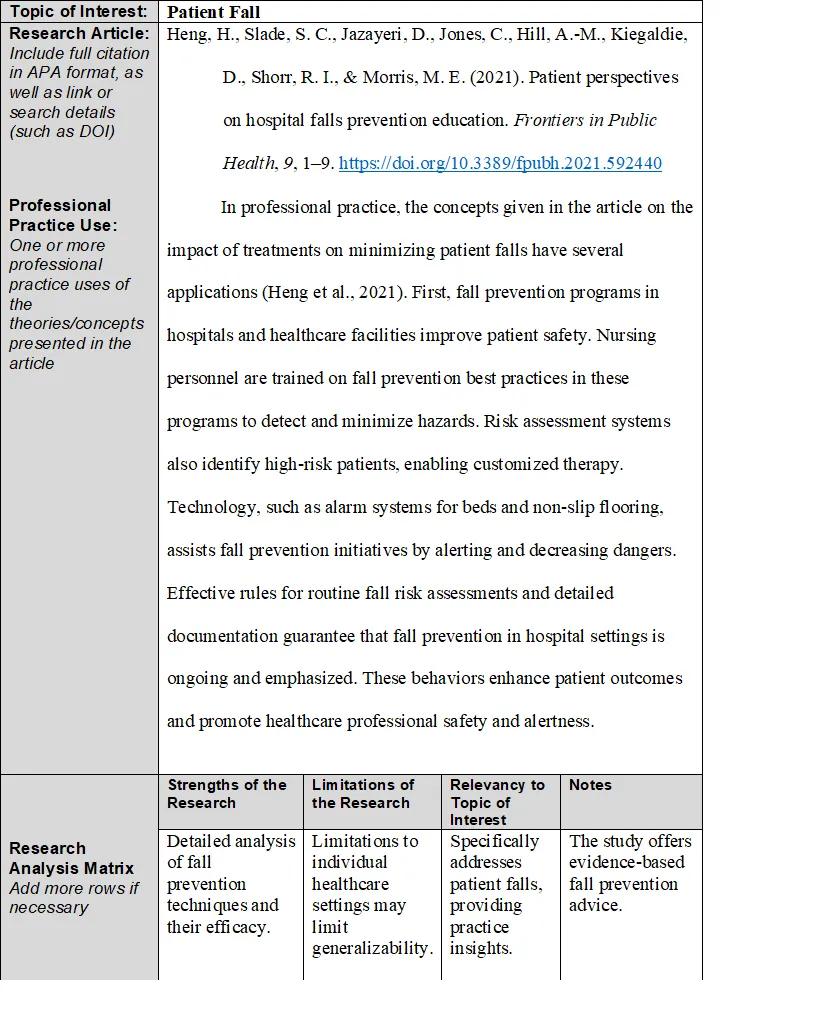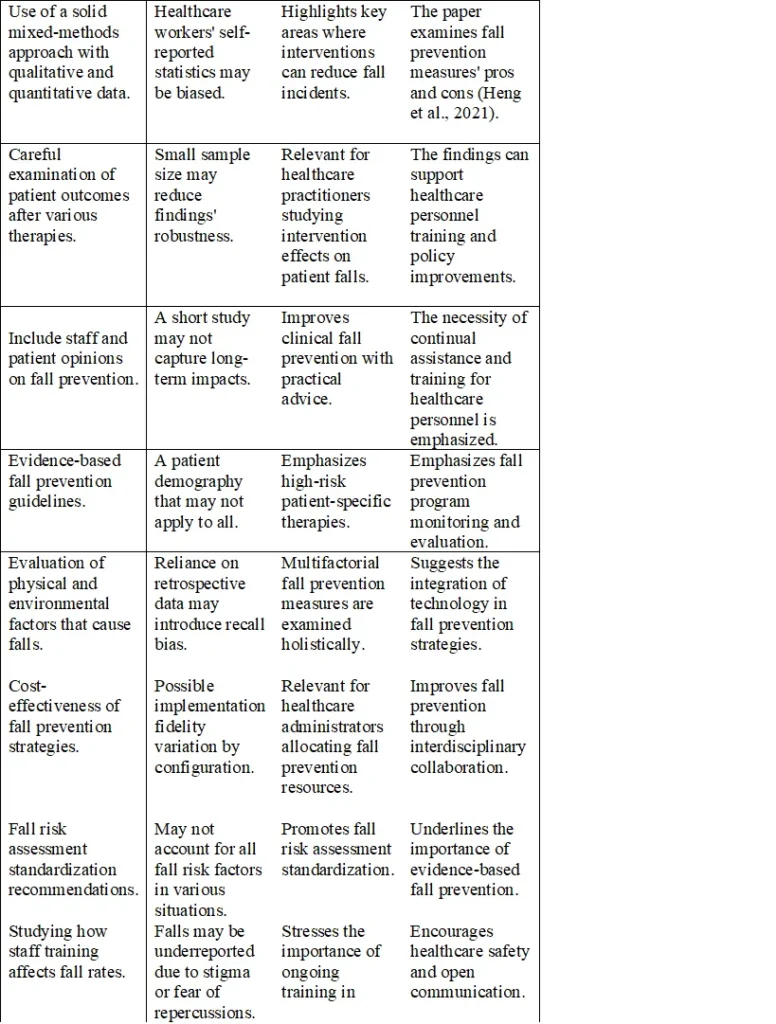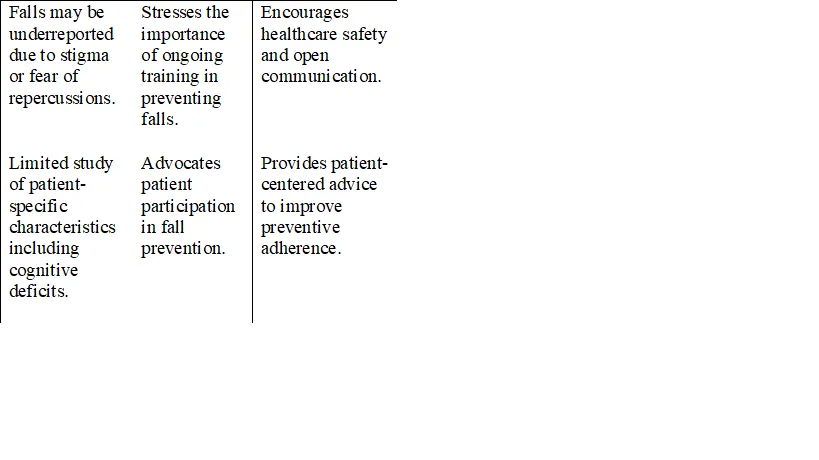
- NURS 6003 Module 3 Assignment Research Analysis.
Step 1: Research Analysis
Complete the table below

NURS 6003 Module 3 Assignment Research Analysis

NURS 6003 Module 3 Assignment Research Analysis

Recommendation
The article “The Impact of Interventions on Reducing Patient Falls in Healthcare Settings” analyzes patient fall prevention measures in depth (Heng et al., 2021). This article is essential to professional practice for various reasons. First, it thoroughly evaluates fall prevention methods to improve patient safety. Adopting a mixed methods approach, which combines qualitative and quantitative data, ensures a well-rounded view encompassing statistical evidence and personal experiences from healthcare personnel and patients. This dual approach is necessary to comprehend fall prevention treatments’ real-world effects.
The study’s findings emphasize the need to develop targeted fall prevention programs that address physical and environmental variables. These ideas are immediately helpful in healthcare, where avoiding falls is essential. The article also advises creating fall risk assessment processes, staff training, and patient participation. These ideas can guide healthcare organizations’ professional development programs, policy, and resource allocation. There are certain restrictions. The study’s healthcare settings may limit the findings. Healthcare worker’s self-reported statistics may also induce bias. Despite these limitations, the research’s extensive analysis, evidence-based suggestions, and practical insights make it worthwhile for professional practice.
Step 2: Summary of Analysis
Craft a summary (2-3 paragraphs) below that includes the following:
Describe your approach to identifying and analyzing peer-reviewed research
- Identify at least two strategies that you would use that you found to be effective in finding peer-reviewed research
- Identify at least one resource you intend to use in the future to find peer-reviewed research
Identifying and Analyzing Peer-Reviewed Research
I chose a topic that aligned with my interests and analyzed peer-reviewed research on patient falls. I searched article databases such as PubMed, CINAHL, and Google Scholar (Gusenbauer & Haddaway, 2020). “Patient falls,” “fall prevention,” “healthcare interventions,“ and “nursing practice“ were used as keywords. Use these terms to filter search results to relevant studies. I reviewed each article’s abstract to make sure it fit my research. I checked the methodology part for research design soundness. Articles with mixed methods or big sample sizes yield more accurate and complete results. I also examined staff and patient views and real-world applications essential for execution.
Strategies
Advanced search filters and citation tracking are two practical strategies that I would use for identifying peer-reviewed research. Advanced search criteria let me filter by publication date, article kind, and journals (Lefebvre et al., 2019). This aids in identifying the more recent and, therefore, relevant to the current situation literature. Limiting the search results to show only peer-reviewed and published publications in the last five years ensured the relevance of the information to current practice in healthcare settings.
Citation tracking also involves examining related papers’ bibliographies and finding further studies (Hirt et al., 2023). This technique identified new basic research and other studies that supported previous findings of this technique. I discovered that I have a set of high-quality papers that provide me with full knowledge when specifying the reference.
Resource
In the future, I will consider the Cochrane Library a resource for locating peer-reviewed research. It is known for its thorough systematic reviews and meta-analyses of healthcare therapies. I may use this resource to get evidence-based summaries and extensive analyses of studies to ensure my research is credible and compelling.
References
Gusenbauer, M., & Haddaway, N. R. (2020). Which Academic Search Systems Are Suitable for Systematic Reviews or meta‐analyses? Evaluating Retrieval Qualities of Google Scholar, PubMed, and 26 Other Resources. Research Synthesis Methods, 11(2), 181–217. https://doi.org/10.1002/jrsm.1378
Heng, H., Slade, S. C., Jazayeri, D., Jones, C., Hill, A.-M., Kiegaldie, D., Shorr, R. I., & Morris, M. E. (2021). Patient perspectives on hospital fall prevention education. Frontiers in Public Health, 9, 1–9. https://doi.org/10.3389/fpubh.2021.592440
Hirt, J., Nordhausen, T., Appenzeller‐Herzog, C., & Ewald, H. (2023). Citation tracking for systematic literature searching: A scoping review. Research Synthesis Methods, 14(3). https://doi.org/10.1002/jrsm.1635
Lefebvre, C., Glanville, J., Briscoe, S., Littlewood, A., Marshall, C., Metzendorf, M., Noel‐Storr, A., Rader, T., Shokraneh, F., Thomas, J., & Wieland, L. S. (2019). Searching for and selecting studies. Cochrane Handbook for Systematic Reviews of Interventions, 67–107. https://doi.org/10.1002/9781119536604.ch4
